by Mitch Hauschildt, MA, ATC, CSCS
Last week I discussed 5 reasons that adults should be crawling. If you haven’t read it, I highly encourage you to go back and look at it, as it explains why I’m such a fan of crawling in general. Once we understand the ‘whys”, it’s important that we look at some of the methods.
I tell my patients that “variety of the spice of life.” Thus, I like to really mix things up with a lot of variations of any movement, so we don’t end up repeating very many things in back to back training sessions. Oftentimes this is because I work hard to have very specific progressions and regressions to keep advancing my patients and also because I like to put my patients in positions to be successful.
Sometimes, however, it’s good to have variety merely for the sake of variety. It keeps patients mentally engaged and training sessions fun. We also know through research that motor learning occurs best when the patient is “playing.” Thus, making any activity fun is really important for improving movement long term.
Also keep in mind that prior to crawling, it is important that your patient or client be proficient in the quadruped position. Some of these remedial movements will help with that process, but taking them through a proper rotary stability progression is important prior to crawling.
This is not an exhaustive list by any means, but here are some good variations of the crawl:
- Cross Crawl in place: No movement required here. This version of crawling is also a variation of the quadruped movement. Keeping a neutral spine, level hips, and shoulders packed, lift 1 foot, knee and the opposite hand. This is an effective way of improving rotational stability in a closed chain exercise the introduces crawling in a simple way.
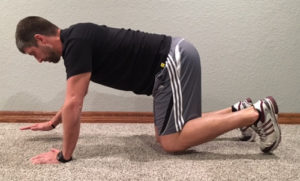
- Cross Crawling – Starting in a quadruped position, move in an opposite arm/opposite leg pattern and ambulate across the floor. This is what most people think of when they think of crawling…hands, knees and toes in contact with the floor. This position provides a lot of stability and is a simple form of crawling that promotes cross body movement. Keep the spine neutral and hips flat and shoulders packed throughout. Also, make sure you start with small steps prior to every attempting larger strides and/or more speed.
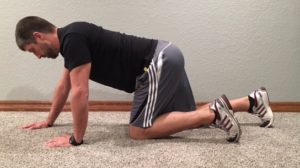
- Bearcrawl in place – legs only – This is another variation of the quadruped or bird dog movement. This time start with both knees off of the floor and supporting yourself with your hands and toes. Pack the shoulders in tight and keep a neutral spine and flat hips. Lift one foot off of the ground while keeping everything neutral and then return it back to the ground in a controlled manner. Alternate legs.
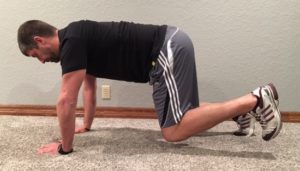
- Bearcrawl in place – arms only – This variation is almost identical to the version above in that it is a static movement with no forward ambulation, but it does test rotary stability. In this variation, instead of lifting a leg, keep the toes dug firmly into the ground and lift one hand. Alternate while limiting all other motion.
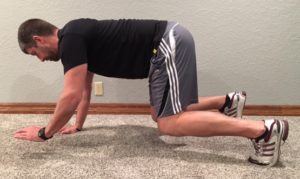
- Bearcrawl in place – arms/legs – This very challenging crawling variation is a mixture of the previous 2 movements. Again, the body isn’t moving forward or backward. This movement involves simply removing 2 opposing bases of support. Limit all other motion by keeping the spine neutral and hips flat and shoulder packed tightly.
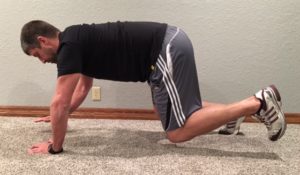
- Bearcrawl – This is the staple variation for many of our athletes. It involves keeping the knees only about an inch off of the floor and walking forward in an opposite arm/opposite leg manner. Focus on small steps and take your time. Also make sure they are working in a cross body pattern. The tendency with bearcrawling is to let the hips rise high into the air with limited knee flexion and to also allow the hips to sway side to side. Neither of these are acceptable. Take your time and do it right.
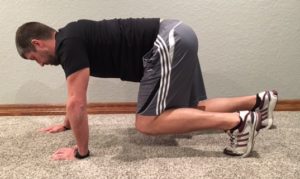
- Lateral Bearcrawl – This variation takes into account all of the important coaching cues from the regular bearcrawl, but instead of moving forward, you are moving laterally. This will challenge trunk stability in a different way and require different scapulothoracic mechanics.
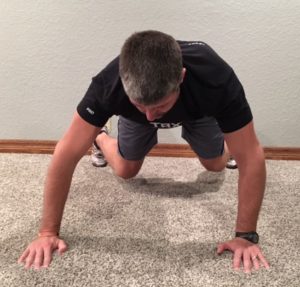
- Crossover Lateral Bearcrawl – This variation is very similar to the lateral bearcrawl with the exception of the fact that you will take larger “steps” with your hands and actually cross them over. This really challenges scapulothoracic stability and motion, so it isn’t for the novice crawler or someone with acute shoulder issues. But, it is very effective for improving scapular stability and mechanics during the later stages of rehab and also for injury prevention.
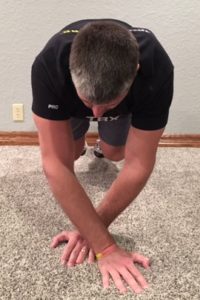
- Reverse Bearcrawl – The exact same mechanics and coaching cues as the regular bearcrawl, but this time, the client is going to ambulate backwards. This places a very different load on the shoulder complex and challenges the trunk stabilizers differently. Most of my patients find this variation more difficult than a regular bearcrawl, so keep that in mind for your progressions and regressions.
- Inchworm Bearcrawl – Similar to a standing “inchworm” or “walkout” movement, this variation of the crawl involves staring in a regular bearcrawl position and then walking the hands out as far as the client can while keeping a neutral spine and hip complex. Then, keeping the hands fixed in place, walk the feet up in small steps until they reach the staring position. Keep working for distance and focus on limited accessary motions.

- Slider Bearcrawl – Arms – Using furniture sliders (or commercial available under the Valslide name), place one under each foot. This will make your feet very easy to slide over the floor. Keeping the quadruped position with a neutral spine, flat hips and knees bent, pull yourself forward only using your arms. The goal is to keep everything still and quiet from the shoulder down, while creating movement with the shoulders.
- Slider Bearcrawl – Legs – This is the same variation as above using furniture sliders, except now the sliders will be placed under the hands. The movement now is simply created with the feet. Be careful here to make sure that the client keeps their hips down and flat. Slow and steady with very controlled movements is the name of the game here.
Be creative with your crawling strategies. Mix things up. Put things together to create complexes as they improve. Add volume when their fitness levels allow. All of these will help to make athletes out of all of your patients, regardless of their goals.


Like the variations with this exercise.